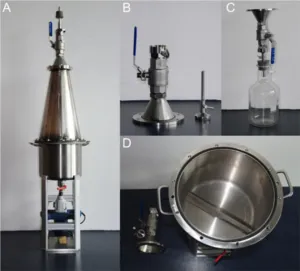Microplastic Particles in Aquatic Systems
Objectives
- Separation, identification and quantification of (micro)plastic particles in aquatic environments
- In-vivo studies on ingestion and possible accumulation of plastic particles in freshwater organisms
Methods of Approach
- Raman Microspectroscopy & Raman Imaging
- Munic Plastic Sediment Separator (MPSS)
Description
In recent years the pollution of marine environments with plastic waste has been well documented. High amounts of plastic particles accumulate in the sediments and in the pelagic zone and can be ingested by many organisms. However, only a few studies are known concerning the amount of discharged plastic particles to freshwater environments. There is a high requirement for scientific studies to examine the potential endangerment by plastic particles of these ecosystems.
A first important step in order to study the consequences of plastic debris in aquatic ecosystems is a reliable, verified and standardized approach to quantify the amount of plastic particles. We developed an accurate method based on density separation in a ZnCl2 solution (at density 1.6 – 1.7 kg/l) and constructed a Munich Plastic Sediment Separator which enables a reliable separation of different types and size classes of plastic particles from sediment samples. Subsequent identification of the particles with spatial resolution down to 1 µm is performed by Raman Microspectroscopy (RM). RM is the combination of Raman Spectroscopy, which is based on the inelastic scattering of light, with optical microscopy.
Moreover, we will investigate the impact of plastic particles on freshwater environments. We will use chosen species as examples for different functional groups and test for accumulation of plastic particles in the organisms and for influences to life-history, reproduction and mortality. Next to sophisticated histological techniques, RM will be used and further developed as an efficient method to show the ingestion and possible accumulation of plastic particles in organisms and organs in-vivo. This will help to foster studies quantifying the increasing contamination of aquatic environments with plastic particles, which is a crucial prerequisite for future risk assessment and management strategies.
Microplastic particles & pigmented (plastic) microparticles
In the last years the risks and concerns about microplastic particles gained awareness as well in the scientific community as in the public media. Microplastic is formed as a result of mechanical, UV- and biological degradation of macroplastic (secondary microplastic) or produced directly for industrial abrasives or care products in cosmetics (primary microplastic). Microplastic is commonly referred to as plastic particles with sizes from 5 mm to 1 µm. However, the discrimination in further size classes is essential for a more specific analysis of the samples:
Megaplastic: > 20 mm
Makroplastic: 20 mm – 5 mm
Large Microplastic Particles (L-MPP): 5 mm – 500 µm
Small Microplastic Particles (S-MPP): 500 µm – 50 µm
Very Small Microplastic Particles (VS-MPP): 50 µm – 1 µm
Plastic and especially microplastic particles are of increasing concern in marine ecosystems, posing risk to the biota. However, a large portion of the plastic waste is produced onshore and enters even headwaters. This may come along with all the associated harmful consequences, which have been reported previously for marine ecosystems. Hence, microplastic particles may also harbor the risk of entering limnetic food webs. However, there is until now a considerable gap of knowledge on the contamination of freshwater ecosystems with (micro)plastic particles. As plastics are used in numerous application and purposes, they are also available in a large scale of color variants. These colorants pose additional harm to the environment because they often contain toxic and hazardous elements.
Contrary to L-MPP and S-MPP, which can also be analyzed by means of IR spectroscopy, Raman Microspectroscopy is the only applicable method for the evaluation of VS-MPP (with this method, a spatial resolution down to 1 µm is possible). RM enables us to not only gain information on the plastic type but also on the used colorants.
We analyze the abundance of plastic particles in beach sediments from the subalpine Lake Garda, Italy. The sample preparation is based on density separation. Identification and quantification is performed using Raman Microspectroscopy. We detect microplastic particles without and with colorants in the beach sediment samples. Mainly polystyrene, polyethylene and polypropylene as plastic types are present. The most prominent colorants are Pigment Blue 15 (Phthalocyanine Blue BN), Pigment green 7 (Polychloro copper phthalocyanine) and Pigment red 48 (Permanent Red BBC). Additional pigmented particles without plastic can be found mainly in the S-MPP and VS-MPP group.
Further research and standardized surveillance guidelines to control for microplastic contamination in freshwater ecosystems should help to foster future risk assessment and conservation strategies. Moreover the development of an automated system for the on-line identification and quantification of microplastic can be adjuvant for a fast analysis.


Pubilcations
H. Imhof, A. Wiesheu, P. Anger, R. Niessner, N. P. Ivleva & C. Laforsch, Variation in Plastic Abundance at Different Lake Beach Zones - A Case Study. Science of the Total Environment 2018, 613/614, 530-537
H. K. Imhof, C. Laforsch, A. C. Wiesheu, J. Schmid, P. M. Anger, R. Niessner & N. P. Ivleva, Pigments and Plastic in Limnetic Ecosystems: A Qualitative and Quantitative Study on Microparticles of Different Size Classes. Water Research 2016, 98, 64-74
N. P. Ivleva, R. Nießner, Kunststoffpartikel in Süßwasser, Nachrichten aus der Chemie 2015, 63, 46-50
H. Imhof, N. P. Ivleva, J. Schmid, R. Niessner & C. Laforsch, Contamination of Beach Sediments of a Subalpine Lake with Microplastic Particles, Current Biology 2013, 23, R867-R868
H. Imhof, J. Schmid, R. Niessner, N. P. Ivleva & C. Laforsch, A Novel, Highly Efficient Method for the Quantification of Plastic Particles in Sediments of Aquatic Environments, Limnology and Oceanography: Methods 2012, 10, 524-537